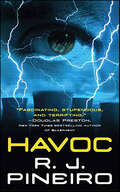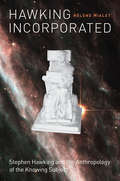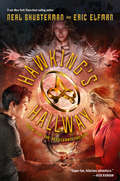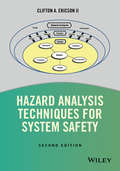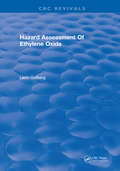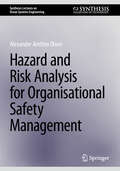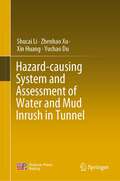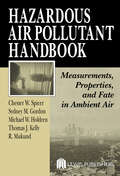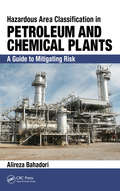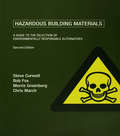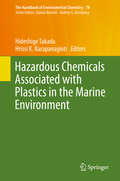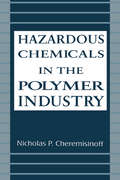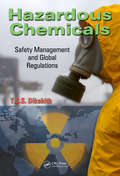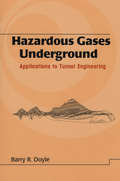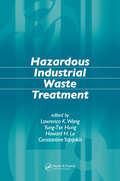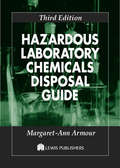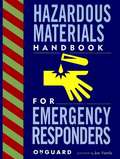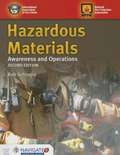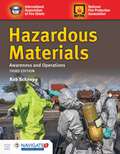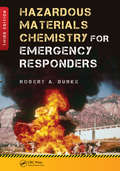- Table View
- List View
Havoc
by R. J. PineiroWhen CIA Officer Tom Grant was pulled out of early retirement to investigate a recent high-tech robbery at United States Nanotechnologies, America's government-run agency for the development of nanoweapons, he had no idea that he would be propelled into the middle of a conspiracy that could threaten the survival of our species. Teaming up with young Rachel Muratani, a rising star in the agency, and Karen Frost, an old hand from the FBI, Grant tracks the cyber thieves to CyberWerke, a German conglomerate run by Rolf Hartman. Hartman has stretched his high-tech empire across Europe, and now plans to use the newly acquired nanotechnology to take his empire global.Among the stolen USN hardware is a prototype nanoassembler, a highly intelligent and self-propelled machine with the capability of creating and destroying any object allowed by the laws of physics, including itself---though it needs access to radioactive material in order to mine the fuel required to power its clones. When the nanoassembler breaks free from its relatively unsophisticated captors, it finds itself no longer restricted by the software shackles imposed on it while at USN. While the megalomaniacal Hartman races to recapture it, Grant and his team must not only stop Hartman, but find away to combat the nanoassembler as it embarks on its own mission to ensure the survival of its species---even if that means the eradication of the human race!At the Publisher's request, this title is being sold without Digital Rights Management Software (DRM) applied.
Havoc and Reform: Workplace Disasters in Modern America (Hagley Library Studies in Business, Technology, and Politics)
by James P. KraftHow disasters—that have wrecked work sites throughout American history, in all parts of the nation and all sectors of the economy—have also inspired policy reform.Workplace disasters have wreaked havoc on countless American workers and their families. They have resulted in widespread death and disability as well as the loss of property and savings. These tragic events have also inspired safety reforms that reshaped labor conditions in ways that partially compensated for death, suffering, and social dislocation. In Havoc and Reform, James P. Kraft encourages readers to think about such disastrous events in new ways. Placing the problem of workplace safety in historical context, Kraft focuses on five catastrophes that shocked the nation in the half century after World War II, a time when service-oriented industries became the nation's leading engines of job growth. Looking to growing areas of economic life in the Western Sunbelt, Kraft touches on the 1947 explosion of the Texas City Monsanto Chemical Company plant, the 1956 airliner collision over the Grand Canyon, the hospital collapses following the 1971 San Fernando earthquake, the 1980 fire at the Las Vegas MGM Grand, and the 1995 bombing of the Oklahoma City Federal Building. These incidents destroyed places of employment that seemed safe and affected a relatively wide range of working people, including highly trained, salaried professionals and blue- and white-collar groups. And each took a toll on the general public, increasing fears that anyone could be in danger of being killed or injured and putting pressure on public officials to prevent similar tragedies in the future.As Kraft considers how these tragedies transformed individual lives and specific work environments, he describes how employees, employers, and public leaders reacted to each event. Presented chronologically, his studies offer a unique and sobering outlook on the rise of a now vital and integral part of the national economy. They also underscore the ubiquity and persistence of workplace disasters in American history while building on and challenging literature about the impact of World War II in the American West. Within a broader frame, they speak to the double-edged nature of modern life.
Hawker's Secret Cold War Airfield: Dunsfold: Home of the Hunter and Harrier
by Christopher BudgenA military aviation expert chronicles the decades of breathtaking innovation that took place at Britain’s secret airbase.In 1951, Hawker Aircraft started using Dunsfold Aerodrome to test its new jet projects. The Sea Hawk was followed by the superlative Hunter. Then came a radical new engine design for an aircraft capable of vertical take-off and landing. While nay-sayers claimed it would never work, the Harrier proved them wrong, becoming a vital asset during the Falklands War.Then came the Hawk, which—after completion of the RAF requirement—was sold into air arms across the world, including the US Navy. It was an incredible achievement for a UK design. British Aerospace then brought forth its upgraded Harrier, the Harrier GR.5.One might expect that this prolific output was the result of some massive industrial plant in the Midlands rather than an isolated aerodrome tucked in the rural hinterland of south Surrey. Shrouded in secrecy for most of its life, Dunsfold has largely escaped the notice of the general public. This volume shines a light on the remarkable work carried out there.
Hawking Hawking: The Selling of a Scientific Celebrity
by Charles SeifeStephen Hawking was widely recognized as the world's best physicist and even the most brilliant man alive–but what if his true talent was self-promotion?When Stephen Hawking died, he was widely recognized as the world's best physicist, and even its smartest person. He was neither. In Hawking Hawking, science journalist Charles Seife explores how Stephen Hawking came to be thought of as humanity's greatest genius. Hawking spent his career grappling with deep questions in physics, but his renown didn't rest on his science. He was a master of self-promotion, hosting parties for time travelers, declaring victory over problems he had not solved, and wooing billionaires. In a wheelchair and physically dependent on a cadre of devotees, Hawking still managed to captivate the people around him—and use them for his own purposes. A brilliant exposé and powerful biography, Hawking Hawking uncovers the authentic Hawking buried underneath the fake. It is the story of a man whose brilliance in physics was matched by his genius for building his own myth.
Hawking Incorporated: Stephen Hawking and the Anthropology of the Knowing Subject
by Hélène MialetThese days, the idea of the cyborg is less the stuff of science fiction and more a reality, as we are all, in one way or another, constantly connected, extended, wired, and dispersed in and through technology. One wonders where the individual, the person, the human, and the body are—or, alternatively, where they stop. These are the kinds of questions Hélène Mialet explores in this fascinating volume, as she focuses on a man who is permanently attached to assemblages of machines, devices, and collectivities of people: Stephen Hawking. Drawing on an extensive and in-depth series of interviews with Hawking, his assistants and colleagues, physicists, engineers, writers, journalists, archivists, and artists, Mialet reconstructs the human, material, and machine-based networks that enable Hawking to live and work. She reveals how Hawking—who is often portrayed as the most singular, individual, rational, and bodiless of all—is in fact not only incorporated, materialized, and distributed in a complex nexus of machines and human beings like everyone else, but even more so. Each chapter focuses on a description of the functioning and coordination of different elements or media that create his presence, agency, identity, and competencies. Attentive to Hawking’s daily activities, including his lecturing and scientific writing, Mialet’s ethnographic analysis powerfully reassesses the notion of scientific genius and its associations with human singularity. This book will fascinate anyone interested in Stephen Hawking or an extraordinary life in science.
Hawking Incorporated: Stephen Hawking and the Anthropology of the Knowing Subject
by Hélène MialetThese days, the idea of the cyborg is less the stuff of science fiction and more a reality, as we are all, in one way or another, constantly connected, extended, wired, and dispersed in and through technology. One wonders where the individual, the person, the human, and the body are—or, alternatively, where they stop. These are the kinds of questions Hélène Mialet explores in this fascinating volume, as she focuses on a man who is permanently attached to assemblages of machines, devices, and collectivities of people: Stephen Hawking. Drawing on an extensive and in-depth series of interviews with Hawking, his assistants and colleagues, physicists, engineers, writers, journalists, archivists, and artists, Mialet reconstructs the human, material, and machine-based networks that enable Hawking to live and work. She reveals how Hawking—who is often portrayed as the most singular, individual, rational, and bodiless of all—is in fact not only incorporated, materialized, and distributed in a complex nexus of machines and human beings like everyone else, but even more so. Each chapter focuses on a description of the functioning and coordination of different elements or media that create his presence, agency, identity, and competencies. Attentive to Hawking’s daily activities, including his lecturing and scientific writing, Mialet’s ethnographic analysis powerfully reassesses the notion of scientific genius and its associations with human singularity. This book will fascinate anyone interested in Stephen Hawking or an extraordinary life in science.
Hawking's Hallway (The Accelerati Trilogy #3)
by Neal Shusterman Eric ElfmanReaders who enjoy strange science, quirky humor, and out-of-this-world plot twists will be captivated by this third and final book in the electrifying Accelerati Trilogy from New York Times bestselling and award-winning author Neal Shusterman and author/screenwriter Eric Elfman.Nick Slate, in order to protect his father and little brother, reluctantly must help the Accelerati complete Tesla's great device. Their power-mad leader wants nothing less than to control the world's energy -- but there are still three missing objects to track down.Nick's friends can't help him, as they are spread across the globe grappling with their own mysteries -- with Vince in Scotland, Caitlin and Mitch on their way to New Jersey, and Petula's whereabouts unknown. On his own, Nick must locate Tesla's final inventions -- which are the most powerful of all, capable of shattering time and collapsing space.Read more in the Accelerati Trilogy:Tesla's AtticEdison's Alley
Haystack
by Bonnie GeisertThe informative text brings to life a fascinating reminder of a working farm.
Hazard Analysis Techniques for System Safety
by Clifton A. Ericson IIA practical guide to identifying hazards using common hazard analysis techniques Many different hazard analysis techniques have been developed over the past forty years. However, there is only a handful of techniques that safety analysts actually apply in their daily work. Written by a former president of the System Safety Society and winner of the Boeing Achievement and Apollo Awards for his safety analysis work, Hazard Analysis Techniques for System Safety explains, in detail, how to perform the most commonly used hazard analysis techniques employed by the system safety engineering discipline. Focusing on the twenty-two most commonly used hazard analysis methodologies in the system safety discipline, author Clifton Ericson outlines the three components that comprise a hazard and describes how to use these components to recognize a hazard during analysis. He then examines each technique in sufficient detail and with numerous illustrations and examples, to enable the reader to easily understand and perform the analysis. Techniques covered include: ∗ Preliminary Hazard List (PHL) Analysis ∗ Preliminary Hazard Analysis (PHA) ∗ Subsystem Hazard Analysis (SSHA) ∗ System Hazard Analysis (SHA) ∗ Operating and Support Hazard Analysis (O&SHA)#60;br /> ∗ Health Hazard Assessment (HHA) ∗ Safety Requirements/Criteria Analysis (SRCA) ∗ Fault Tree Analysis (FTA) ∗ Event Tree Analysis (ETA) ∗ Failure Mode and Effects Analysis (FMEA) ∗ Fault Hazard Analysis ∗ Functional Hazard Analysis ∗ Sneak Circuit Analysis (SCA) ∗ Petri Net Analysis (PNA) ∗ Markov Analysis (MA) ∗ Barrier Analysis (BA) ∗ Bent Pin Analysis (BPA) ∗ HAZOP Analysis ∗ Cause Consequence Analysis (CCA) ∗ Common Cause Failure Analysis (CCFA) ∗ MORT Analysis ∗ Software Safety Assessment (SWSA) Written to be accessible to readers with a minimal amount of technical background, Hazard Analysis Techniques for System Safety gathers, for the first time in one source, the techniques that safety analysts actually apply in daily practice. Both new and seasoned analysts will find this book an invaluable resource for designing and constructing safe systems-- in short, for saving lives.
Hazard Assessment Of Ethylene Oxide
by Leon GolbergHazard assessment of EO has involved consideration of the chemical composition, characteristics, and reactivity of this material. Teratogenic effects of EO are only seen under extreme conditions that render the result questionable. Reproductive effects or minor severity occur only at high levels of exposer. Epidemiological and other studies of occupational exposure to EO in men and women have revealed no substantial evidence of potential to produce cancer in the work place.
Hazard and Risk Analysis for Organisational Safety Management (Synthesis Lectures on Ocean Systems Engineering)
by Alexander Arnfinn OlsenThis book provides a comprehensive exploration of health and safety in the workplace, focusing on critical safety design, functional safety, and applying risk analysis. Through this book, readers will learn to navigate the complex landscape of organizational safety management, ensuring safe systems of work in hazardous environments. The chapters cover topics such as preliminary hazard identification and analysis, understanding and applying risk analysis, and constructing robust safety cases and arguments. The authors present an expert analysis of these themes through the lens of real-world examples and empirical research. Readers will also discover diverse perspectives from renowned scholars and practitioners in the field, making this book a must-read for anyone involved in organizational safety management. This book is essential for health and safety professionals, industrial and process engineers, and students at all levels studying engineering or safety courses. By the end of this volume, readers will be equipped with the knowledge to explain core principles of organizational safety management and apply them effectively in their work environments.
Hazard-causing System and Assessment of Water and Mud Inrush in Tunnel
by Xin Huang Shucai Li Zhenhao Xu Yuchao DuThis book is composed of eight chapters, introducing the authors’ research and application achievements in the hazard-causing system and disaster evaluation of water and mud inrush in tunnels over the past 10 years. Through a large number of case studies and analysis, and on the basis of existing research, this book puts forward 3 categories and 11 types of tunnel water and mud inrush hazard-causing systems and 4 typical water and mud inrush disaster-forming modes. The authors carefully study the typical cases of tunnel water and mud inrush hazard-causing system, discuss the types of karst water system, structural characteristics, macro-geological identification, engineering identification, karst tunnel route selection principles and evaluation methods in detail, and then develop a dynamic evaluation method of tunnel water and mud inrush construction risk interval and an evaluation method for the resistance body. Ultimately, the authors put forward a systematic identification method of tunnel water and mud inrush disaster, which integrates geological identification, geophysical exploration identification, and drilling identification, and construct a dynamic management and analysis platform for tunnel water and mud inrush cases.This book is used as a reference book for teachers, graduate students, and undergraduates in colleges and universities of civil engineering, transportation, water conservancy and hydropower, mining, geology, etc., and also as a reference for technicians in related engineering fields.
Hazardous Air Pollutant Handbook: Measurements, Properties, and Fate in Ambient Air
by Thomas J. Kelly Chester W. Spicer Sydney M. Gordon Michael W. Holdren R. MukundHazardous Air Pollutant Handbook: Measurements, Properties, and Fate in Ambient Air provides a comprehensive review of the 188 compounds and compound classes designated as Hazardous Air Pollutants (HAPs) by the Clean Air Act Amendments of 1990, with a specific focus on their potential presence in ambient air. The relevant chemical and physical prop
Hazardous Area Classification in Petroleum and Chemical Plants: A Guide to Mitigating Risk
by Alireza BahadoriDue to an increase in the wide-range of chemicals in petrochemical processing industries, as well as frequency of use, there has been a steady rise in flammability problems and other hazards. Hazardous Area Classification in Petroleum and Chemical Plants: A Guide to Mitigating Risk outlines the necessities of explosion protection in oil, gas and ch
Hazardous Building Materials: A Guide to the Selection of Environmentally Responsible Alternatives
by Bob Fox Chris March Steve Curwell Morris GreenbergThis new edition provides a detailed reference source of the use in residential buildings of materials known or suspected to harm health and the environment. Alternative materials are evaluated using unique data sheets which compare environmental impact, cost, health, safety and technical performance providing building and construction professionals and other practitioners with the facts they need to make the right selection.Hazardous Building Materials considers the following building elements: structure, windows and doors, roofing, insulation, finishes and fittings, pipes, services and services equipment. Based on the highly successful format of the first edition this practical reference provides expert advice with the use of clear drawings, tables and data sheets to architects, surveyors, facilities managers, students on built environment courses, material suppliers, environmentalists and clients.
Hazardous Chemicals Associated with Plastics in the Marine Environment (The Handbook of Environmental Chemistry #78)
by Hideshige Takada Hrissi K. KarapanagiotiThis volume consists of 15 chapters and focuses on hazardous chemicals, how they are associated with plastics, and their environmental risks. It includes background information on plastics and additives chemistry, and their observed or potential effects on living organisms as well as the oceanographic aspects of marine debris dispersion. The respective chapters provide insights into the sorption/desorption of chemicals in and out of plastics, the mechanisms and kinetics, but also the scale of the concentrations of chemicals found in marine debris, particularly in microplastics. The occurrence of the various chemicals is analyzed, as well as the distribution profiles of the chemicals in microplastics throughout the world’s oceans. The implications of the fact that plastics carry within them several chemicals are discussed in detail. In closing, new research topics that warrant further attention are identified. The book will appeal to all scientists who are already working or interested in starting to work on the topic of marine debris, as well as policymakers, NGOs and the broader informed public.
Hazardous Chemicals in the Polymer Industry (Environmental Science And Pollution Ser. #14)
by NicholasP. CheremisinoffProvides accurate, up-to-date information on the hazardous properties of several hundred generic and specific polymeric additives used in elastomer and plastics processing operations, detailing the symproms of overexposure as well as resonsible packaging, shipping and emergency-response procedures. Essential safety data is offered.
Hazardous Chemicals: Safety Management and Global Regulations
by T.S.S. DikshithAn easily accessible guide to scientific information on safety management of chemical substances for students and occupational health professionals, this book covers proper management, related care, and precautions, and related global regulations. It aids in preventing and minimizing the consequences of catastrophic releases of toxic, reactive, flammable, or explosive chemical substances, which may result in toxic or explosive hazards. It also details safety measures for transportation of chemical substances by different routes, such as by road, rail, air, and sea.
Hazardous Gases Underground: Applications to Tunnel Engineering (Civil and Environmental Engineering)
by Barry DoyleApplies detailed knowledge toward the design and construction of underground civil works projects. Develops critical skills for managing risk and designing reliable gas control measures within project time and cost constraints.
Hazardous Industrial Waste Treatment (Advances in Industrial and Hazardous Wastes Treatment)
by Lawrence K. Wang Yung-Tse Hung Howard H. Lo Constantine YapijakisIncreasing demand on industrial capacity has, as an unintended consequence, produced an accompanying increase in harmful and hazardous wastes. Derived from the second edition of the popular Handbook of Industrial and Hazardous Wastes Treatment, Hazardous Industrial Waste Treatment outlines the fundamentals and latest developments in hazardous waste
Hazardous Laboratory Chemicals Disposal Guide
by Margaret-Ann ArmourA perennial bestseller, this third edition includes individual entries for over 300 compounds. The extensive list of references has been updated and includes entries for 15 pesticides commonly used in greenhouses. Emphasis is placed on disposal methods that turn hazardous waste material into non-toxic products. These methods fall into several categories, including acid/base neutralization, oxidation or reduction, and precipitation of toxic ions as insoluble solids. The text also provides data on hazardous reactions of chemicals, assisting laboratory managers in developing a plan of action for emergencies such as the spill of any of the chemicals listed.
Hazardous Materials
by Joe VarelaHazardous Materials Handbook for Emergency Responders breaks down the hazards and response priorities according to the nine classes of hazardous chemicals defined by the U.N. and the U.S. Department of Transportation. Designed to prepare HazMat professionals for all three levels of response, as defined by OSHA, the Handbook:Offers the most complete and current coverage of control and mitigation techniques for chemical emergencies.Provides extensive treatment of transportation and storage vessels.Helps users comply with all relevant government regulations and standards, including OSHA and NFPA training requirements.
Hazardous Materials Awareness And Operations
by Rob SchnappA fire fighter's ability to recognize an incident involving hazardous materials or weapons of mass destruction (WMD) is critical. They must possess the knowledge required to identify the presence of hazardous materials and WMD, and have an understanding of what their role is within the response plan. The second edition of Hazardous Materials Awareness and Operations will provide fire fighters and first responders with these skills and enable them to keep themselves and others safe while mitigating these potentially deadly incidents.
Hazardous Materials Awareness and Operations
by Rob SchneppA fire fighter’s ability to recognize an incident involving hazardous materials or weapons of mass destruction (WMD) is critical. They must possess the knowledge required to identify the presence of hazardous materials and WMD, and have an understanding of what their role is within the response plan. The Third Edition of Hazardous Materials Awareness and Operations will provide fire fighters and first responders with these skills and enable them to keep themselves and others safe while mitigating these potentially deadly incidents. Hazardous Materials Awareness and Operations, Third Edition has been completely updated and correlated to meet and exceed the competencies in the newly released 2017 Edition of NFPA 1072: Standard for Hazardous Materials/Weapons of Mass Destruction Emergency Response Personnel Professional Qualifications. A detailed crosswalk has also been developed to help you correlate the JPR’s from the 2018 Edition of NFPA 472: Standard for Competence of Responders to Hazardous Materials/Weapons of Mass Destruction Incidents which can be found as an appendix. The structure of the Third Edition has also been enhanced to accommodate your exact needs with three distinct sections: The Awareness section encompasses two chapters for awareness level personnel The Operations section covers five chapters for operational responders The Mission Specific section concludes with eight chapters
Hazardous Materials Chemistry for Emergency Responders
by Robert BurkeThe third edition of a bestseller, Hazardous Materials Chemistry for Emergency Responders continues to provide the fundamentals of "street chemistry" required by emergency response personnel. Emergency response and hazmat expert Robert Burke takes the basics of chemistry appropriate for response personnel and puts it into understandable terms. The
